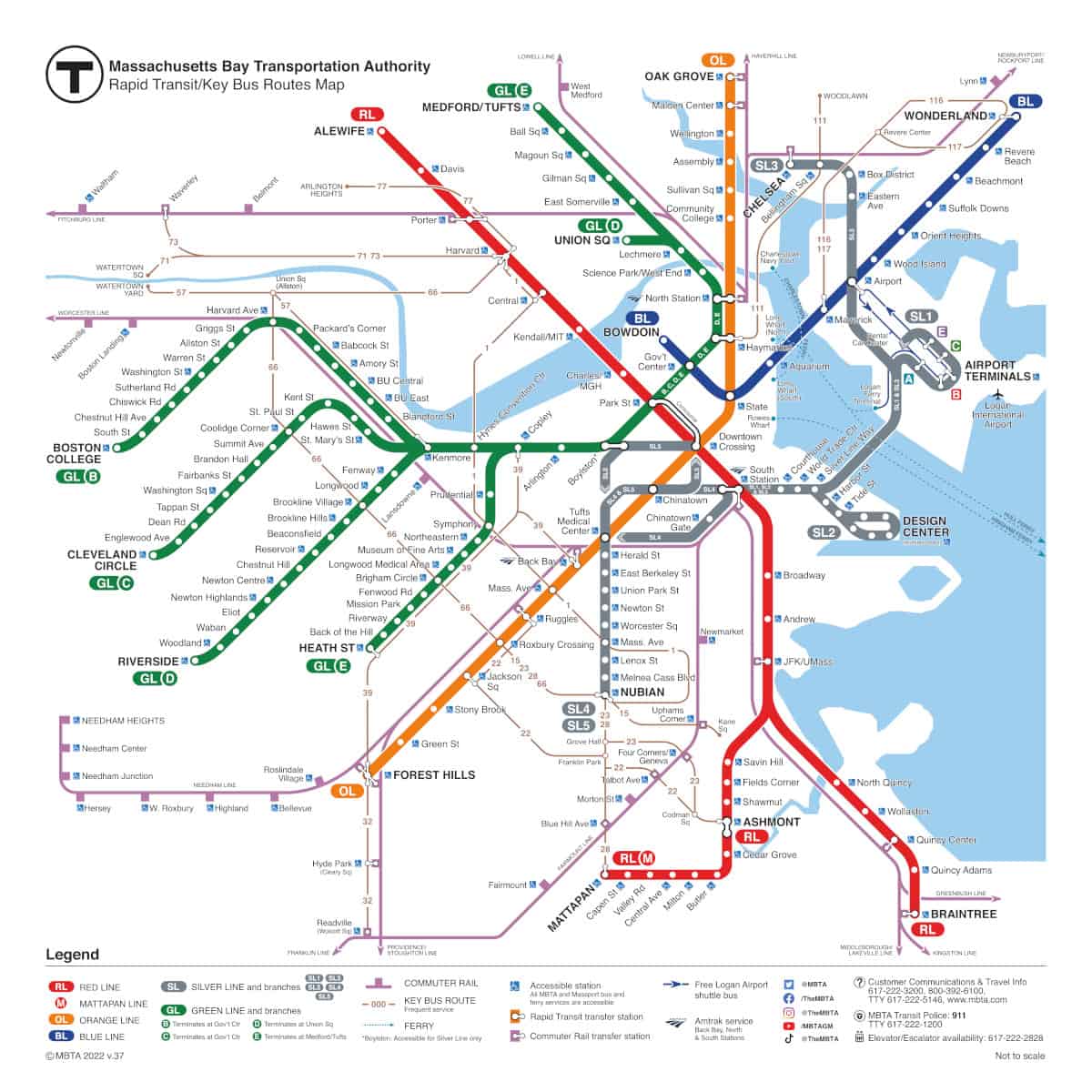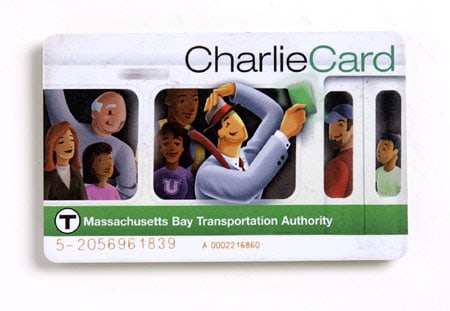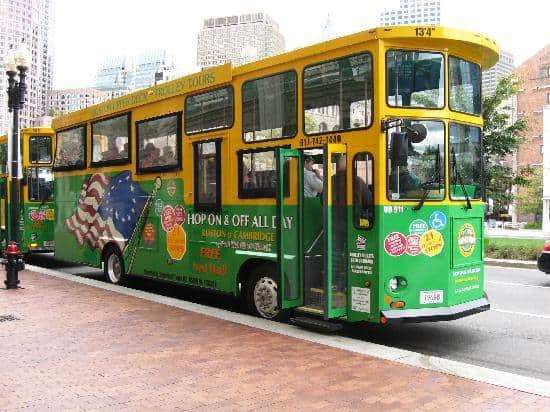This post covers the Boston subway system (known as the T), including a subway map, tips on choosing the right train line, fares, and travel cards.
Stations are conveniently located throughout the city (we even start most of our free walking tours at a station).
- Subway Map
- Fares & Subway Passes
- Use the MBTA As a Local
- Subway vs. Hop-On-Hop-Off Bus
- Tourist Discount Passes
- Things to Do in Boston
BOSTON SUBWAY MAP

The T: Boston's Public Transportation System
The Blue, Green, Orange, and Red Lines, which run beneath the city are color-coded for the section of the city it travels through.
Every line, with the exception of the blue line, can be used to reach the Boston Commons, which is the start of the Freedom Trail.
- Blue Line: The Blue Line will take you to the beaches, Old State House, and Logan International Airport.
- Green Line: Travels along the series of parks in Boston known as the Emerald Necklace. Use this line to reach the Faneuil Hall, Boston's North End neighborhood, the Museum of Science, the Museum of Fine Arts, and the Symphony Hall. The line passes through stations like North Station, Haymarket, Boylston Streets and Fenway Park.
- Orange Line: Takes you to Faneuil Hall, Boston's North End neighborhood, the TD Garden (formerly the Boston Garden) home of Boston Celtics and Boston Bruins, Boston's Back Bay neighborhood, and the Samuel Adams Brewery.
- Red Line: Takes you to Harvard University and Cambridge, Massachusetts Institute of Technology (MIT), and the JFK Library. This line takes passes through station like Park Street Station, South Station and Broadway.
- Mattapan Trolley: Takes you Ashmont, Cedar Grove, Butler, Milton, Central Avenue, Valley Road, Capen Street & Mattapan.
The destinations are listed on the front of each train, it tells you the last stop the train will be going to.
All the stops are marked the same with the names of the stations and maps on the walls of each station.
Fun Fact: The State Street Station on the Blue or Orange subway lines (one of the exits as there are five) is beneath the Old State House (1713) which was the Capital Building until 1798. It is now a museum called the Old State House Museum.
SUBWAY FARES
The cost of a one-way trip is $2.40 with a Charlie Card, a Charlie Ticket, or Cash. CharlieTickets are available at every stop using a self-serve machine.
Charlie Cards can be picked up at the Downtown Crossing MBTA (Massachusetts Bay Transportation Authority) and can be reloaded.
The fare includes a free transfer to the buses.
The Purple Line, also known as the Commuter Rail, is a separate line and the cost is not covered by the CharlieCard or paper tickets.
The Purple Line is a separate fare that can be purchased at the stations which they serve.
Depending on where you are going determines how much the fare will cost.
The cost of the Silver Line (buses) is covered with a Charlie Card or paper ticket.
It doesn't matter where you are going, for the buses in the city the fare is the same $1.70, and is included in your subway fare if you are using both.
Important Changes
As of March 31st, 2022, insertable Charlie Tickets will no longer be available for purchase.
Instead, you'll need to purchase the new tapable Charlie Tickets. This new option allows you to simply tap your ticket on or near a ticket reader and be granted entry.
All this means is you won't need to insert your ticket into any device, and instead you can just tap your ticket to receive admission to the subway or bus.
The idea behind this change is to make it safer for people to travel around Boston following the pandemic.
This should also help you save time when boarding, as it takes a bit less time to simply tap your ticket.
TRAVEL PASSES AND CHARLIE CARDS
If you are thinking of using the MBTA as your primary way to travel through Boston, the best deal by far is the weekly pass.
These passes can be purchased at the self-serve ticket machines and cost $22.50
The weekly pass can be used for unlimited travel from the time/day of purchase to 7 days after the time/day of purchase.
There is a daily pass for $12.75 a day and a monthly pass cost $90 a month.
The best deal is the weekly even if you are only staying for two or three days because after using it for 5 round trips, every other trip is free.
Just a note: In order to avoid a passenger scanning their weekly ticket and handing it off to a friend to use at the same time; once you scan the ticket you cannot use the ticket for 10 to 15 minutes after it is scanned.

Boston's Charlie Card
The Charlie Card was introduced in 2006 and previously it was just called a Subway Pass for monthly holders and tokens were purchased for daily riders.
When the system was upgraded, the tokens were removed from the system and all fares had to be purchased with either a card (that can be reloaded) or a paper ticket.
When deciding on a new name for the Card, a few of the rejected names included:
The Fare Cod, making a joke about the way Bostonians pronounce the word card and the fish that is associated with Boston, as well as the T Go Card; which let’s face it, is a boring name.
The name for the Charlie Card was taken from the Kingston Trio Band's song Charlie on the MBTA.
Where to get a Charlie Card?
The only place you can purchase a Charlie Card is Downtown Crossing Station on the Red or Orange lines at The Charlie Card Store.
Fun Fact: Boston’s transit system also boasts the nation’s first art in transit collection which first appeared in 1967. Throughout the system, you can view artwork from professional artists to artwork from Boston’s School Children. The art collection includes over ninety pieces on its six transit lines.
For more information on schedules, fares, and maps go to the MBTA website at www.mbta.com
USE THE MBTA LIKE A LOCAL | "T" FAQs
Don't want people to know you're from out of town? Here are some tips to use the subway like a Bostonian.
When the train pulls into the station, be nice and let the folks disembark before entering the train.
Sounds simple, but you would be amazed at how many passengers rush the door and block people trying to get out.
If you have a bicycle, they are allowed on the Subway during non-rush hours, from 10:00 am to 3:30 and after 7:00 pm.
The seats next to the door are reserved for passengers with disabilities and seniors.
You can sit in these seats, but if an elderly person, or person with a disability, boards, you should offer that seat (or any seat you are sitting on) to that person.
Most stations have working elevators, but not all stations have escalators. If the stairs are an issue there is usually the option of using the elevators.
Load up your Charlie Card for how many rides you will use.
It saves time to do it all at once as sometimes there can be lines at the pay stations, and who wants to miss a train while waiting to put cash on your Charlie Card?
Your Charlie Card is also good for MBTA buses and if you ride the subway and then connect to the bus the transfer from the train to a bus is free.
What are Peak and Off-Peak hours?
Peak and Off-peak are essentially rush hour and non-rush hours for the purposes of commuting.
Weekday Peak hours are 7:00 am to 9:30 am and 4:00 pm - 7:00 pm.
Is there a reduced fare for Children or Seniors?
Children 11 years old and younger traveling with an adult and people who are blind or visually impaired may ride MBTA services for free.
Seniors, people with disabilities, and some students are eligible for reduced fares.
Do I have to purchase a Charlie for every member of my party?
You can use one Charlie Card for everyone in your group but will need to load up enough money on the card to cover the cost of everyone (except children under 11 years old who can travel for free).
You will need to tap the card for as many people going through the gate.
Please do not try and sneak on, as they do issue tickets for anyone caught sneaking on the MBTA.
How do I calculate how much my trip will cost?
Each one-way ride on the Subway is $2.40 with your Charlie Card and $4.80 round trip.
Can I get to the airport by Subway?
Yes! And this is a quick and easy way to get from downtown Boston to Logan Airport.
Just take the Blue Line to the Airport Stop and there are buses outside the stop to take you to your terminal.
How do you pay for the T in Boston?
To pay for the T in Boston, you have several options. At subway stations, you can purchase tickets or add value to a reusable CharlieCard at ticket machines.
These machines accept cash and credit/debit cards. Alternatively, you can download the MBTA mTicket app to purchase and display digital passes on your smartphone for subway and commuter rail rides.
Additionally, CharlieCards can be obtained and reloaded at select retail locations, as well as at customer service locations and the MBTA's website.
Why is the Boston Subway called the T?
The Boston Subway is called the "T" because it is an abbreviation for "MBTA," which stands for Massachusetts Bay Transportation Authority.
The nickname originated from the use of the letter "T" to represent the subway system on maps and signage.
The choice of "T" is believed to have been inspired by the word "trolley" or "traction," as the system initially used electric streetcars or trolleys for transportation.
What is the difference between the commuter rail and the T in Boston?
The main difference between the commuter rail and the T in Boston lies in their scope and purpose.
The T refers to the subway system that primarily serves the urban areas of Boston with multiple lines and underground stations.
The commuter rail, on the other hand, is a regional rail system that connects the suburbs and outlying areas to the city, providing transportation for longer distances.
While both are operated by the Massachusetts Bay Transportation Authority (MBTA), the T focuses on intra-city transportation, while the commuter rail serves inter-city and suburban commuters.
Does the Boston Subway have tap to pay service?
As of Jan 2024, this facility is not available. But soon you will be able to do so.
Work is under progress and upon completion, you will be able to tap and board at any door with a fare card, smartphone, or contactless credit card.
HOP-ON-HOP-OFF BUSES VS.THE SUBWAY
We hope that we have demonstrated the benefit of taking the subway to get to Boston's main tourist points of interest.
Still, we understand that some people may still be apprehensive or are torn between the benefits of both the subway and the tourist hop-on-hop-off buses.
So, we have included a few pros and cons of each service to help you make up your mind.
This photo of Boston Upper Deck Trolley Tours is courtesy of TripAdvisor
Hop-on-hop-off buses are also a great way not only to see the sites with a local guide but can also be used for transportation.
The hop-on-hop-off buses have stops where you can board and disembark at major sites around the city including Faneuil Hall, Massachusetts State House, and The Boston Common.
Pros of a Bus Tour
- many spots to pick up the tour along the bus routes
- convenient stops at the most popular tourist attractions
- climate controlled all year
- tickets often include free admission to other sites
- a guided tour along the route going by major tourist sites in Boston
Cons of a Bus Tour
- much more expensive than riding the subway
- the bus makes frequent stops as they pick up other guests
- wait times can be long in high season due to traffic
- buses can be crowded in the high season
- bad weather is always a risk
Pros of Riding the Subway
- inexpensive
- flexible routing
- you'll stay warm in the winter and cool in the summer.
- you can commute like a real Bostonian.
- will likely get you to our destination quicker.
- taxis are also easily available at most of the stations
- no traffic jams or dealing with the famously aggressive drivers on Boston's streets.
Cons of Riding the Subway
- not all stations have working elevators.
- there can sometimes be delays, although usually runs on time.
- can be really crowded during rush hours
- no commentary
- bikes are banned from several stations
- during peak hours you will more than likely be standing.
And don’t forget our walking tours.
All tours start and end within walking distance of a station and our guides can make sure you know the best way to get to and from any place you want to see in the most direct route.










